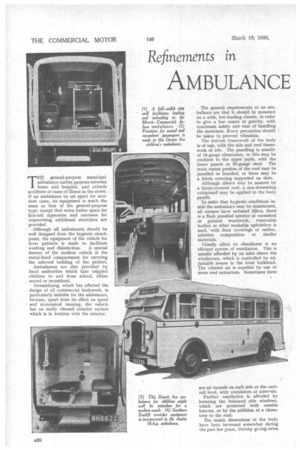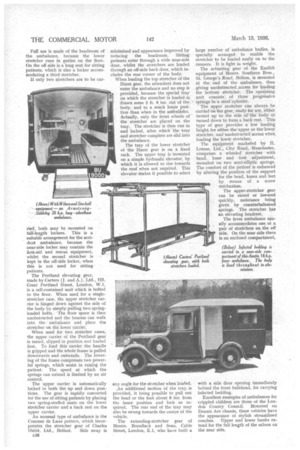Refinements in
Page 88

Page 89

Page 90

If you've noticed an error in this article please click here to report it so we can fix it.
AMBULANCE BODYWORK
and Equipment
THE general-purpose municipal ambulance carries patients between home and hospital, and attends accidents or cases of illness in the street. If an ambulance be set apart for accident cases, its equipment is much the ' same as that of the general-purpose
• type, except that extra locker space for first-aid apparatus and canvases for improvising additional stretchers are provided.
Although all ambulances should be " well designed from the hygienic standpoint, the equipment of the vehicle for fever patients is made to facilitate washing and disinfection. A special feature of the modem vehicle is the metal-lined compartment for carrying the infected bedding of the patient. Ambulances are also provided by local authorities which take crippled . 'children to and from school, either seated or recumbent.
Streamlining, which has affected the design of all commercial bodywork, is • particularly suitable for the ambulance, because, apart from its effect on speed , and economical running, the vehicle has an easily cleaned exterior surface which is in keeping with the interior. The general requirements of an amburance are that it should be mounted on a wide, low-loading chassis, in order to give a low centre of gravity, with maximum safety andease of handling the stretchers, Every precaution should be taken to prevent vibration.
The bottom framework of the body is of oak, with the side and roof framework of ash. The panelling is usually. of 16-gauge aluminium, or this may be confined to the upper parts, with the lower panels in 20-gauge steel. The main centre portion of the roof may be panelled or boarded, or there may be a fabric covering supported on slats.
Although silence may be assured by a fabric-covered roof, a non-drumming compound may be applied to the body panels.
In order that hygienic conditions inside the ambulance may be maintained, all• corners have radiused fillets, there is a flush panelled interior of varnished or painted woodwork, removable leather or other washable upholstery is used, with floor coverings of rubber, asbestos composition or similar materials.
Closely allied -to cleanliness is an efficient system of ventilation. This is usually afforded by an inlet above the windscreen, which is controlled by adjustable means in the front bulkhead. The vitiated air is expelled by one or more roof extractors. Sometimes there are air tunnels on each side at the cantrail level, with ventilators at intervals.
Further ventilation is afforded by lowering the balanced side windows, which are protected with outside louvres, or by the addition of a clerestory to the roof.
The inside dimensions of the body have been increased somewhat during the past few years, thereby giving extra
comfort for the patient and ease of , handling the stretchers. An inside length of 7 ft. 10 ins. to 8 ft. and a . width of 5 ft. 4 ins. to 5 ft. 6 ins, are not unusual. Headroom remains much about the same at 5 ft., although some ambulances exceed 5 ft. 6 ins, in width and have a stretcher space 9 ft. long.
Apart from a low floor level, entry and exit with a loaded stretcher are facilitated by low and broad steps. The step immediately below the general floor level is often built as a well in the body, whilst the lower step reverses over it and is finished on the underside to match the floor covering. The stepwell is usually of the same width as the central gangway, but particular ease of access is afforded when this step-well is the full width of the body. , The most important feature of the ambulance—the stretcher mounting— has now to be discussed.
One type of equipment made by Messrs. Wilson and Stockall, Bury, Lanes, has a near-side upper stretcher mounted on a spring-assisted raising and lowering device. This folds directly to the side of the body when not required. There is no direct attachment to the floor or roof, thus providing a resiliency which gives added comfort to the patient. Full use is made of the headroom of the ambulance, because the lower stretcher runs in guides on the floor. On the off side is a long seat for sitting patients, which is also a locker accommodating a third stretcher.
If only two stretchers are to be car
ried", both may be mounted on full-length lockers. This is a suitable arrangement for the accident ambulance, because the near-side locker may contain the first-aid and rescue equipment, whilst the second stretcher is kept in the off-side locker, when this is not used for sitting patients.
The Portland elevating gear, made by Carters (J. and A.), Ltd., 125, Great Portland Street, London, W.1, is a self-contained unit which is bolted to the floor. When used for a singlestretcher case, the upper stretcher carrier is hinged down against the side of the body by simply pulling two springloaded bolts. The floor space is then unobstructed and the bearers can walk into the ambulance and place the stretcher on the lower carrier.
When used for two stretcher cases, the upper carrier of the Portland gear is raised, slipped in position and loaded first. To load this carrier the handle is gripped and the whole frame is pulled downwards and outwards. The lowering of the frame compresses two powerful springs, which assist in raising the patient. The speed at which the springs can extend is limited by an air control.
The upper carrier is automatically locked in both the up and down positions. The gear is rapidly converted for the use of sitting patients by placing two spring-stuffed seats on the lower stretcher carrier and a back rest on the upper carrier.
An unusual type of ambulance is the Commer de Luxe pattern, which incorporates the stretcher gear of Charles
Hurst, Ltd., Belfast. Side sway is c38
minimized and appearance improved by reducing the headroom. Sitting patients enter through a wide near-side door, whilst the stretchers are loaded through an off-side back door, which includes the rear corner of the body.
When loading the top stretcher of the Hurst gear, the attendant does not enter the ambulance and no step is provided, because the special tray on which the stretcher is loaded is drawn some 2 ft. 6 ins, out of the body, and to a much lower position than when in the ambulance. Actually, only the front wheels of the stretcher are placed on the tray. The stretcher is then run in and locked, after which the -tray and stretcher complete are slid into the ambulance.
The tray of the lower stretcher of the Hurst gear is on a fixed rack. The upper tray is mounted on a simple hydraulic elevator, by which it is allowed to rise towards the roof when not required. This elevator makes it possible to select any angle for the stretcher when leaded.
,An additional motion of the tray, is provided, it being possible to pull out the head or the foot about 6 ins, from the inner position and lock as required. The rear end of the tray may also be swung towards the centre of the vehicle.
The extending-stretcher gear of Messrs. Bonallack and Sons, Cable Street, London, E.1, who have built a
large number of ambulance bodies, is specially arranged to enable the stretcher to be loaded easily on to the runners. It is light in weight.
The actuating gear of the Easilift equipment of Messrs, Southern Bros., St. George's Road, Bolton, is mounted at the end of the ambulance, thus giving unobstructed access for loading. the bottom stretcher. The operating unit consists of three progressive springs-in 'a steel cylinder. The upper stretcher can always be carried on the gear, ready for use, either, turned up to the side of the body or turned down to form a back rest. This type of gear provides a low loading height for either the upper or the' lower stretcher, and unobstructed access when
loading the lower stretcher. .
The equipment marketed by H. Lomas, Ltd., City Road, Manchester, comprises a wheeled stretcher with 'head, knee and foot adjustment, mounted on two semi-elliptic springs. The comfort of the patient is enhanced by altering the position of the support for the head, knees and feet by means of a screw mechanism.
The upper-stretcher gear can be raised or lowered quickly, assistance being given by counterbalanced springs. The stretcher has an elevating headrest.
The fever ambulance usually accommodates one or a pair of stretchers on the off side. On the near side there is an enclosed compartment,
with a side door opening immediately behind the front bulkhead, for carrying infected bedding.
Excellent examples of ambulances for crippled children are those of the London County Council. Mounted on Dennis Ace chassis, these vehicles have the appearance of stylish streamlined coaches. Upper and lower bunks extend for the full length of the saloon on the near side.


























































































































































